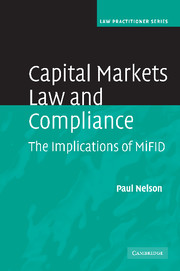Book contents
- Frontmatter
- Contents
- Preface
- List of acronyms
- Part I Evolution of capital markets regulation, FSA and the European single market
- Part II Licensing and rule application
- Part III The firm's infrastructure
- Part IV Conduct of business
- 8 Client classification and client documentation
- 9 Principles of conduct
- 10 Marketing investments
- 11 Advising clients
- 12 Improper behaviour in dealing and executing orders
- 13 Dealing and executing orders
- 14 Exchanges and MTFs
- Part V Application of rules to particular businesses
- Bibliography
- Index
8 - Client classification and client documentation
Published online by Cambridge University Press: 03 December 2009
- Frontmatter
- Contents
- Preface
- List of acronyms
- Part I Evolution of capital markets regulation, FSA and the European single market
- Part II Licensing and rule application
- Part III The firm's infrastructure
- Part IV Conduct of business
- 8 Client classification and client documentation
- 9 Principles of conduct
- 10 Marketing investments
- 11 Advising clients
- 12 Improper behaviour in dealing and executing orders
- 13 Dealing and executing orders
- 14 Exchanges and MTFs
- Part V Application of rules to particular businesses
- Bibliography
- Index
Summary
Regulatory policy
Pre-MiFID: Regulators have always taken the view that ‘the professional will be deemed capable of looking after his own interests’ and, so, subject to a lower level of protection, the issues being, first, how to define a professional and, second, how low that level should be in contrast to retail clients. At one end of the spectrum, the 1939 PFI (2.3) exempted from registration any firm whose ‘main business … consists of … effecting any transaction with a person whose business involves the acquisition and disposal or the holding of securities … as a principal’ because, as a matter of policy, there was ‘the necessity of avoiding any undue interference with … legitimate “finance” in the City of London … [by] banks, merchant bankers, discount houses, issuing and finance houses’ in the Primary Market. The policy under the 1986 FSAct was, however, rather different in that ‘[c]ertain basic safeguards … should apply to everyone and are essential if the UK is to be seen as a clean place to do business’, ‘[t]he … distin[ction being] … between professional and non-professional investors, for purposes of determining the level of protection to be afforded’. SIB ended up with a threefold classification under which it is ‘not … appropriate to apply Conduct of Business Rules which are designed to protect individuals and institutions in their capacity as customers of … firms to the relationship between market professionals acting as competitors and professional counterparties.
- Type
- Chapter
- Information
- Capital Markets Law and ComplianceThe Implications of MiFID, pp. 225 - 253Publisher: Cambridge University PressPrint publication year: 2008



